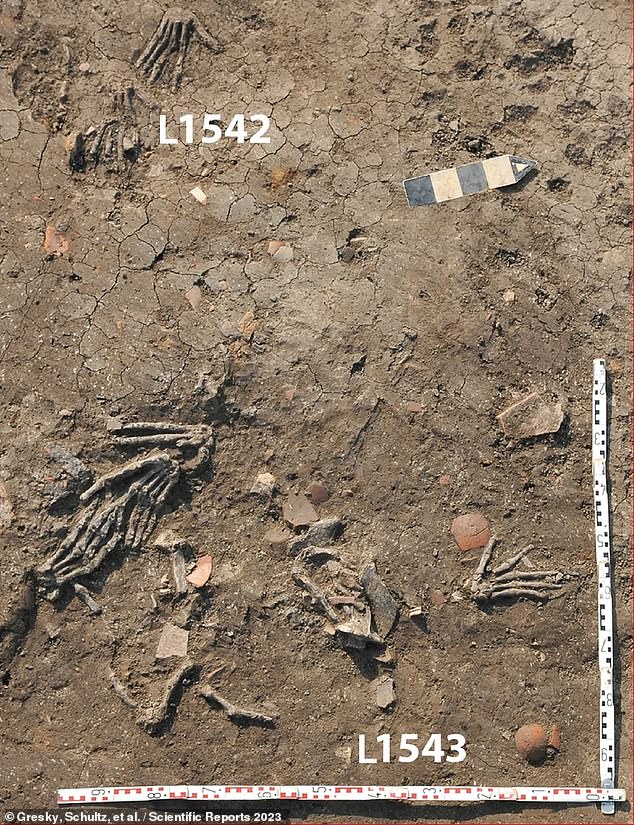Scientists have uncovered the shocking truth about 12 severed hands buried in ancient Egyptian burial pits.
They determined that the remains — all right hands — were mostly from men, with possibly one female, and may provide evidence of the grisly ‘gold of honor’ ritual.
The discovery offers physical proof of an ancient practice in which Pharaoh’s warriors presented the severed right hands of their enemies in exchange for a prestigious reward: a collar of golden beads.
Before the unearthing of these cleanly severed hands, the ‘gold of honor’ ritual was known only through Egyptian tomb inscriptions and temple reliefs dating back to 1550–1077 BC.
However, the hands suggest the ritual may have been practiced nearly a century earlier, as they were found at the Hyksos palace, the seat of power for Egypt‘s 15th Dynasty (1640–1530 BC), invaders from West Asia.
‘It’s delicate work,’ French anthropologist Dr. Isabelle Crevecoeur said. ‘That, for me, is a good argument they did it for a ritual.’
‘No signs of rough cutting suggest it was done very carefully,’ Dr. Crevecoeur elaborated, noting she was not directly involved in the bone study. ‘Not with an ax or something.’
The hands were discovered in three pits within the courtyard ruins of the decaying Hyksos palace, located at Tell el-Dab’a, the modern name for the ancient city of Avaris.
‘After removing any attached forearm parts, the hands were placed in the ground with wide-splayed fingers, mainly on their palmar sides,’ the team reported of these ‘trophies.’

Archeologists and other scientists now believe that the 12 hands found in Hyksos palace are physical evidence of an ancient ritual practice, ‘gold of honor,’ in which the Pharaoh’s warriors would offer up the severed right hands of their enemies in exchange for a prestigious award

The hands cleanly separated from the victim’s body , which experts said was a sign that the remains were trophies
The careful bone anatomy analysis was performed by the German-Austrian team helped determine the approximate age and sex of those whose hands were ritually chopped off.
This osteological work, they said, included a ‘taphonomic’ study of the burial, decay, and preservation processes that would also impact the shape of these skeletal remains, to help rule out other causes for the shape of the bones on display.
But more straightforward biological analyses of the bones were also conducted.
Because male index fingers are known to be longer than their ring fingers, as compared to women’s fingers, 11 of the hands were determined to be male.
But, it could not be ruled out that the twelfth hand was that of a female, the researchers said.
They estimated a minimum age at time of each hand’s dismemberment to be somewhere between 14 to 21 years, as the bones were fully formed and post adolescent.

A string of seven fly amulets (above), made between 1600 and 1070 BC, represented strength and tenacity to the ancient Egyptians. These Golden Fly adornments served as an award for bravery bestowed upon soldiers who demonstrated exceptional courage in battle, like the ‘gold of honor’

Above, a relief of Horemheb – the last pharaoh of the 18th Dynasty of Egypt – receiving the ‘gold of honor’ collar from king Tutankhamun. Before unearthing the 12 severed hands, this ‘gold of honor’ ritual was only known to Egyptian scholars as hearsay, detailed in temple reliefs like this

The macabre severed hands were found in the forecourt of Hyksos palace in northeast Egypt’s ancient city of Avaris – once territory of the invading Hyksos dynasty, now a archeological site
The upper age range was estimated to be under 60, given that the hands show no signs of age-related degeneration.
‘This evidence,’ as the team put it in their study, ‘adds more detail regarding trophy-taking practices in Ancient Egypt.’
They hypothesized that the ancient Hyksos people had ‘recurring propagandist motives’ for placing the severed hands where they were found in this Hyksos palace courtyard.
But the researchers pointed out that it is still ‘unclear if the hands were taken from dead or living individuals’, although they ‘must have been soft and flexible when they were placed into the pit’, before rigor mortis set in or after it had ended.
The most likely scenario is they were placed into the pit somewhere between 24 and 48 hours after being removed from the rest of the body.

Above, an aerial view of the Hyksos palace courtyard – where the grisly remains of 12 young victims’ hands were laid, over three millennia ago, likely as part of a ceremony to honor warriors.
Iconographic evidence of severed hands (pictured) is shown an inscription in the tomb of Ahmose at El-Kab depicting a very realistic representation of an outstretched palm
Four universities, including Germany’s Göttingen University Medical School and the Austrian Academy of Sciences, collaborated on the study of the severed ancient hands.
Austrian archaeologist Dr Manfred Bietak told the news desk of the journal Science that he believes the ‘gold of honor’ ritual was probably introduced to Egypt by the invading Hyksos.
The Hyksos, who ruled Egypt for roughly a century, likely arrive from the eastern Mediterranean, introducing chariots and new types of weapons to this civilization in north Africa.
That said, the researchers remain humble about the vast gap in information on these ancient practices that hinder absolute confidence in their conclusions.
‘Much information on the lives, habits, and history of the Ancient Egyptians is depicted on temple and tomb walls, as well as recorded on papyri, etc.,’ the wrote in their study.
‘Like today, information can create certain ideas, exert political influence, and also present facts in a different and not necessarily realistic light,’ they admitted. ‘Unfortunately, in history and even more so in prehistory, we are limited to a few sources, sometimes only to one.’
This article was originally published by a www.dailymail.co.uk . Read the Original article here. .


